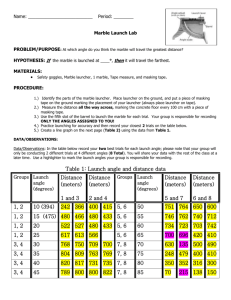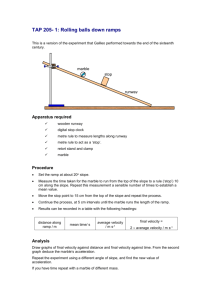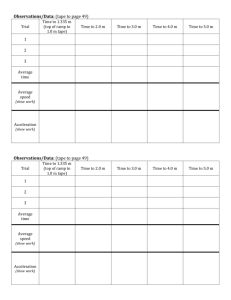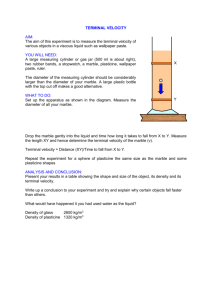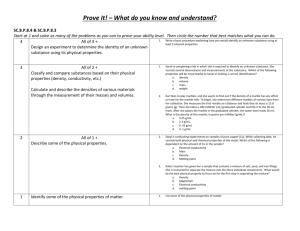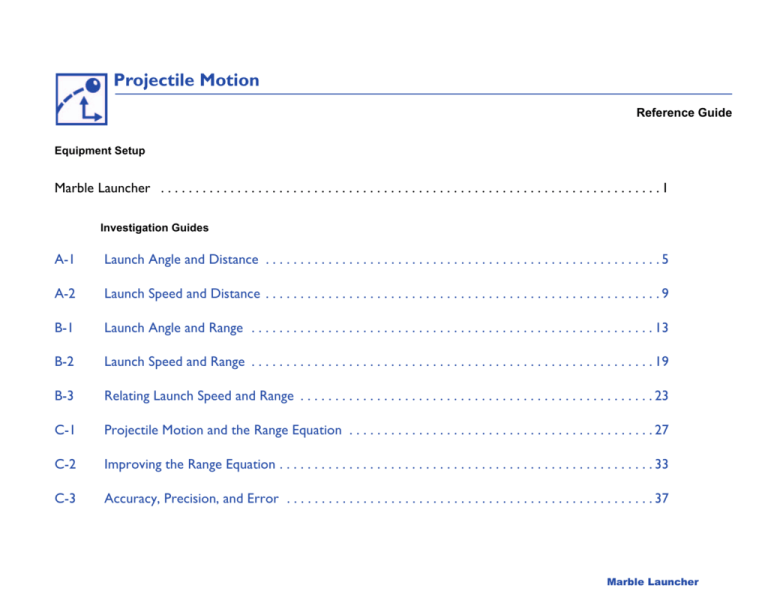
Projectile Motion
Reference Guide
Equipment Setup
Marble Launcher . . . . . . . . . . . . . . . . . . . . . . . . . . . . . . . . . . . . . . . . . . . . . . . . . . . . . . . . . . . . . . . . . . . . . . . . 1
Investigation Guides
A-1
Launch Angle and Distance . . . . . . . . . . . . . . . . . . . . . . . . . . . . . . . . . . . . . . . . . . . . . . . . . . . . . . . . . 5
A-2
Launch Speed and Distance . . . . . . . . . . . . . . . . . . . . . . . . . . . . . . . . . . . . . . . . . . . . . . . . . . . . . . . . . 9
B-1
Launch Angle and Range . . . . . . . . . . . . . . . . . . . . . . . . . . . . . . . . . . . . . . . . . . . . . . . . . . . . . . . . . . 13
B-2
Launch Speed and Range . . . . . . . . . . . . . . . . . . . . . . . . . . . . . . . . . . . . . . . . . . . . . . . . . . . . . . . . . . 19
B-3
Relating Launch Speed and Range . . . . . . . . . . . . . . . . . . . . . . . . . . . . . . . . . . . . . . . . . . . . . . . . . . . 23
C-1
Projectile Motion and the Range Equation . . . . . . . . . . . . . . . . . . . . . . . . . . . . . . . . . . . . . . . . . . . . 27
C-2
Improving the Range Equation . . . . . . . . . . . . . . . . . . . . . . . . . . . . . . . . . . . . . . . . . . . . . . . . . . . . . . 33
C-3
Accuracy, Precision, and Error . . . . . . . . . . . . . . . . . . . . . . . . . . . . . . . . . . . . . . . . . . . . . . . . . . . . . 37
Marble Launcher
Level C
C-1 Projectile Motion and the Range Equation
C-1
Key Question: How can you predict the range of a launched marble?
Preparation
This Investigation assumes that students are already familiar with the
concept of projectile motion. Students may need to do the first two
Level B Investigations prior to this one. In addition, you may need to
review trigonometry and vectors.
The Investigation begins with a derivation of the range equation from
consideration of the x and y components of the marble's initial velocity.
It is assumed that the marble starts and ends at the same elevation
(y = 0). The resulting range equation is used to make predictions about
the motion of the marble which are tested by experiment.
Setup and Materials
Students work in groups of four at tables.
Each group should have:
•
•
•
•
•
Marble launcher
At least one black plastic marble per group. At least one spare marble per group is recommended.
Ruler, meter stick, or tape measure
Scientific calculator
Roll of masking tape
Each student should have:
•
Copy of the Investigation and answer sheet
The Investigation
Time
One class period
Leading •
Questions •
•
What is projectile motion?
How can you derive the range equation?
How does theory compare to actual measurements?
Learning In this Investigation, students will:
Goals • Derive the range equation.
•
•
Test the theory with actual measurements.
Compare predictions to measurements.
Key Vocabulary projectile motion, trajectory, range equation
Projectile Motion and the Range Equation
In this Investigation, students derive an equation that allows them to predict the range of the marble
given the initial velocity and launch angle. First, they derive the range equation. Next, they test their
predictions. Finally, they compare theoretical predictions to actual measurements using a range vs.
launch angle graph. Stress safety when using the marble launcher.
27
Investigation Answers
Investigation Page
A
1a. The path of the marble is a curved path because after
the initial launch, the marble is acted upon by the
force of gravity. The force of gravity pulls down, while
the initial thrust pushes horizontally.
1b. The marble’s velocity in x stays the same during the
flight time. The marble’s velocity in y decreases over
time.
C-1
Question: How can you predict the range of a launched marble?
C-1
In this Investigation, you will find and test a model that will predict the range of the marble from
the initial velocity and launch angle.
You have learned that the motion of any object moving through the air
affected only by gravity is an example of projectile motion. Examples of
projectile motion include a basketball thrown toward a hoop, a car driven
off a cliff by a stunt person, and a marble launched from the CPO marble
launcher. Projectile motion is also called two-dimensional motion because
it depends on two components: vertical and horizontal. In this
Investigation, you will determine a mathematical model (the range
equation) that predicts the range of the marble given launch angle and
initial velocity.
Teaching Notes: Cartesian (x,y) Coordinates
The motion of the marble follows a curved path through space. To tell
where the marble is at any moment, a method must be devised to
measure space in two directions. One method is called the Cartesian,
or x-y coordinate system.
In the Cartesian system, there are two axes, the x and the y that are
constructed perpendicular to each other as shown below. The position
of the marble at any time can be specified by the coordinates. The
coordinates are specified as a pair of measurements (x, y) where x and
y are distances along the x and y axis. For example, the coordinates of
the marble in the figure below are (4.3, 2.8) meters.
Projectile Motion and the Range Equation
A
Analyzing the motion of the marble in two dimensions
How can you predict the range of the marble? Since gravity pulls down and not sideways, the motion
of the marble must be separated into components. It makes sense to pick one component (y) in the
vertical direction aligned with gravity. The other component (x) is then chosen to be in the horizontal
direction, perpendicular to the force of gravity. The diagram below shows the velocity of the marble
(v) at three points in its trajectory, resolved into x and y components, vx and vy.
With Cartesian coordinates, the position is specified relative to the
origin. The origin is the point with coordinates (x, y) = (0, 0). The
location of the origin is usually chosen to be convenient for the
experiment.
a.
b.
Use the diagram above to explain why projectiles travel in a curved path called a trajectory.
How does the marble’s velocity in x change over the time of the flight? How does its velocity in y
change over the time of flight?
1
28
Projectile Motion
Investigation Page
Investigation Answers
B
B
C-1
Understanding the velocity equations
The object of this Investigation is to find and test a model that will predict the range of the marble from
the initial velocity and launch angle—the range equation.
a.
The first step is to separate the velocity of the marble into x and
y components. Use the triangle formed by velocities (at right) to
express vx and vy in terms of the initial velocity, v, and the sine
and cosine of the launch angle, θ.
Equation 1b
b.
v y = v sin θ
2b.
2c.
2d.
v y = v yi + a y t
1
x = xi + vxit + ax t 2
2
Equation 2b
1
y = yi + v yi t + a y t 2
2
Equation 1a: vx = v cosθ
Equation 2a: x = vt cosθ
vx = vxi + ax t
Equation 2a
vx = v cos θ
Equation 1b: v y = v sin θ − gt
When the initial velocity is separated into x and y components, Equations 1a-2b give the relationships
between the motion variables separately for x and y. In these equations the subscript i refers to the
initial values at launch.
Equations 1a and 1b are for the marble’s velocity while equations 2a and 2b are for the marble’s
position.
Equation 1a
2a.
1
Equation 2b: y = vt sin θ − gt
2
v sin θ
ttop =
g
2v 2 sin θ cos θ
x=
g
Teaching Notes: The Range Equation
Since gravity does not pull up or sideways, one of the accelerations (ax, ay) is -g, and the other is zero.
For the first approximation, the range (x) is defined so the initial x and y positions are also zero.
Rewrite Equations 1a-2b leaving out terms that are zero and substituting your previous results for vxi
and vyi.
Equation 1a:
The range equation (2d above) predicts the range of the marble from
two measured quantities: initial velocity (vi) and launch angle (θ).
This equation has two properties that are readily observable in
experiments:
•
•
The range increases as the square of the initial velocity.
A graph of the product of sinθcosθ vs. launch angle shows that
the range has a maximum at 45 degrees as shown below.
Equation 1b:
Equation 2a:
Equation 2b:
c.
d.
The purpose of this exercise is to find a theory that predicts where the marble will land (the range, x)
given the initial velocity and launch angle. This problem can be solved in several steps. First, assume
that gravity acts only on the y component of velocity. Solve for the time it takes the marble to reach its
maximum height (where vy = 0).
Since gravity does not pull sideways, the x component of the marble's velocity is not affected and
remains constant. Use Equation 2a to calculate the range (x) from vxi and the total time of flight (this
will be the range equation).
2
Investigation C-1 Projectile Motion and the Range Equation
29
Investigation Answers
Investigation Page
C Student responses are not required for Part 3.
Teaching Notes: Polar (r, θ) Coordinates and Trigonometry
Another way to locate a point in two dimensions is with polar
coordinates. Polar coordinates use the distance from the origin
(radius, r), and the angle (θ) between the x axis and a line from the
origin to the point. The figure below shows how to specify the
location of the marble using polar coordinates.
In the Investigation, students convert back and forth between polar
and Cartesian coordinates. This conversion is done with trigonometry,
using the relationship between the three angles and three sides of a
right triangle. The right triangle has a 90 degree angle. This is useful
because 90 degrees is also the angle between the x and y axes of a
graph. The figure below shows a right triangle with one angle and
three sides labeled. The Cartesian coordinates correspond to the
lengths of the x and y sides of the triangle.
In a right triangle, all of the sides and angles can be deduced knowing
only two sides, or one side and one angle because the ratios of the
sides depend only on the included angle. These ratios have been given
the names sine, cosine, and tangent, and are:
C
Setting up the marble launcher
C-1
1. Attach one photogate to the
marble launcher so that the
marble breaks the light beam
as it comes out of the barrel.
Put the timer in interval mode,
and connect the photogate to
input A. The launcher can
launch at angles from 0
(horizontal) to 90 degrees
(vertical). For this experiment,
you will use angles from 0 to
80 degrees.
The photogate attaches to the
tab on the end of the wood
piece that supports the barrel.
Be sure the light beam crosses
the center of the barrel.
2. Use a strip of masking tape on
the floor to make sure that the
marble launcher is consistently
placed in the same location. A
tape measure laid along the
floor provides a good range
reference.
3. To launch marbles, pull the
launching lever back and slip it
sideways into one of the slots.
Put a marble in the end of the
barrel and the marble launcher
is ready to launch.
4. There are five notches that
change the compression on the
spring and give different
launch speeds. In this
experiment, you will change
the launch speed setting for
different launches.
SAFETY RULES:
• Never launch marbles at people.
• Wear safety glasses or other eye protection when launching marbles.
• Launch only the black plastic marbles that come with the marble launcher.
3
30
Projectile Motion
Investigation Page
Investigation Answers
D Sample data for spring setting 3:
D
C-1
Doing the experiment
1. To check your theory, a spread of data for different launch angles and initial velocities will be
needed. For each spring setting you should have five different launch angles from 20 degrees to 80
degrees. To cover both variables (angle and speed), at least 20 data points are needed.
2. A minimum of two people are needed per launcher. One person launches the marbles and the other
person/people watches where they land.
3. Use only the black plastic marbles provided by CPO.
4. Record the spring setting, launch angle, time from photogate A, and measured range for each
launch. It often takes several launches with the same setup to locate the landing point precisely. For
each setup, you may need to run several trials until the measured range is consistent within 5 cm.
5. Calculate the initial velocity by dividing the distance traveled (width of marble = 0.019 m) by the
time at photogate A. Record initial velocities in the table. A larger version of the table is found on
your answer sheet.
Spring setting (1 - 5):
Launch angle
Range
(degrees)
(m)
E
Distance
(m)
0.019
0.019
0.019
0.019
0.019
Time from A
(sec)
b.
c.
Initial
velocity
3.45
4.75
Comparing theory predictions to measured data
Initial velocity
(m/sec)
Launch angles (degrees)
6.13
7.31
x (predicted)
x (measured)
Make a graph showing the range vs. launch angle for several
different initial velocities. The graph at right is one example of
how this graph could look. You could also choose other ways to
graph the data. Plot the measured points as unconnected dots and
the theoretical values as solid lines since the theory predicts the
speed of the marble at all points.
How does your theory compare with your measurements? In
particular, is there a consistent deviation between theory and
experiment? The word “consistent” means the difference
between the theoretical and experimental data seems to depend on something in the experiment and is
not random. For example, a consistent deviation would occur if the measured range for small angles is
always smaller than predicted by theory regardless of the velocity. Explain how the consistent
deviations you found are affected by velocity and angle.
Consistent deviations indicate that something is missing from the theory. What is missing, and why
does it have the observed effect on your results?
Range
2.69
3.51
3.76
3.72
3.18
2.23
Time
.0031
.0031
.0031
.0031
.0031
.0031
Velocity
6.13
6.33
6.33
6.33
6.33
6.33
E Sample data:
Initial velocity
(m/sec)
Use the table to help you compare your measured data to theory predictions using your range equation.
Fill in several launch angles for each initial velocity. A larger table is found on your answer sheet.
a.
Angle
20
30
40
50
60
70
8.64
x (pred)
x (meas)
x (pred)
x (meas)
x (pred)
x (meas)
x (pred)
x (meas)
x (pred)
x (meas)
20
0.78
1.17
1.48
1.96
2.46
2.69
3.50
4.08
4.89
5.20
Launch angles
30
40
50
60
1.05 1.20 1.20 1.05
1.25 1.43 1.31 1.12
1.99 2.27 2.27 1.99
2.31 2.39 2.33 1.48
3.32 3.77 3.78 3.32
3.51 3.76 3.72 3.18
4.72 5.37 5.37 4.72
5.00 5.33 5.25 4.45
6.59 7.50 7.50 6.59
6.35 6.95 7.03 5.11
70
0.78
0.83
1.48
1.42
2.46
2.23
3.50
3.33
4.89
4.05
5a. Graph:
4
Part 5 answers continued on the next page.
Investigation C-1 Projectile Motion and the Range Equation
31
Assessment Answer Key
1.
2.
The flight off the table will go higher and farther. The portion
of the flight from the launcher to the apex of the flight (top of
the arc) will be unchanged, except for starting at the height of
the table. Because of this extra height, it will fly higher than the
marble launched from the floor. The portion of the flight from
the apex to the ground will now take longer, since it has farther
to fall. Because of the longer time, it will have a longer range
(i.e., the horizontal velocity is unchanged, but the time spent
traveling at this velocity is no longer).
Answers are:
3.
Answer:
E Answers, continued.
5b. There are consistent differences between theoretical and
measured data. The measured value for range is
consistently higher than the predicted values at small
angles. The deviation becomes more noticeable at slower
initial velocities.
The range is smaller than predicted for faster initial
velocities at large angles.
5c. The derivation of the range equation assumed that the
marble took the same amount of time to fall down as it did
to go up. The real time to fall back to the ground is longer, so
the range should be greater in the measured values.
The differences at faster initial velocities and large angles
could be due to air friction which slows the marble down
slightly.
4.
2 ( 6.33) sin 80D cos80D
x=
= 1.40 m
9.8
2
32
Investigation C-1 Projectile Motion and the Range Equation
Curriculum Resource Guide: Marble Launcher
Credits
CPO Science Curriculum Development Team
Author and President: Thomas Hsu, Ph.D
Vice Presidents: Thomas Narro and Lynda Pennell
Writers: Scott Eddleman, Mary Beth Abel, Lainie Ives, Erik Benton and
Patsy DeCoster
Graphic Artists: Bruce Holloway and Polly Crisman
Curriculum Contributors
David Bliss, David Lamp, and Stacy Kissel
Technical Consultants
Tracy Morrow and Julie Dalton
Curriculum Resource Guide: Marble Launcher
Copyright
2002 Cambridge Physics Outlet
ISBN 1-58892-047-X
2 3 4 5 6 7 8 9 - QWE - 05 04 03
All rights reserved. No part of this work may be reproduced or transmitted in any form or by an means,
electronic or mechanical, including photocopying and recording, or by any information store or retrieval
system, without permission in writing. For permission and other rights under this copyright, please contact:
Cambridge Physics Outlet
26 Howley Street,
Peabody, MA 01960
(800) 932-5227
http://www.cpo.com
Printed and Bound in the United States of America


